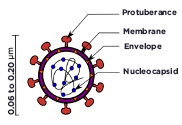14/10/2024


18 November 2020
More than 5,000 coronaviruses have been identified, but only seven can be transmitted to humans, including SARS-CoV-2, which is responsible for the Covid-19 disease. It is highly contagious. Infection occurs particularly via droplets or aerosols from respiratory secretions and especially in enclosed areas. Living in the purest possible indoor air is therefore both a health precaution and a preventive measure.
Coronaviruses are a large family of viruses (more than 5000 are listed). They are so named because of the crown-shaped spikes on their surfaces (figure 1). They range from 60 to 200 nm in diameter.
Only seven of them have been identified as being transmissible to and by humans:
The first four cause mild symptoms and are responsible for 15-30% of colds.
 The first three caused deadly epidemics in 2003, 2012 and 2020.
The first three caused deadly epidemics in 2003, 2012 and 2020.
The 229E strain is the one used for the NatéoSanté conducted tests of the EOLIS Air Manager air purifier. The results obtained, under the supervision of an independent laboratory, demonstrated an efficacy of 99.6% in only 10 minutes
In detail, coronaviruses are composed of four main components (Figure 2):
 Figure 2: Coronavirus diagram
Figure 2: Coronavirus diagram
The difference from one coronavirus to another lies in the composition of its RNA genome. For example, the genome of SARS-CoV-2 is 79% identical to that of SARS-CoV and 50% identical to that of MERS-CoV.
While the two names are often used synonymously with each other, strictly speaking the infectious respiratory disease Covid-19 is caused in humans by the SARS-CoV-2 virus.
Its name comes from:
SARS-CoV-2 is highly contagious for two main reasons:
The EOLIS Air Manager professional air purifier uses five effective anti-virus technologies to ensure the purest possible indoor air: